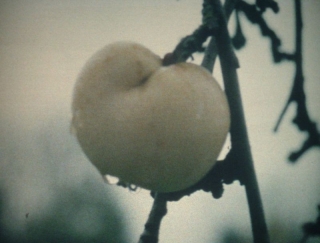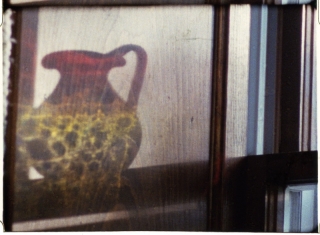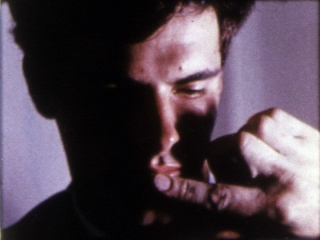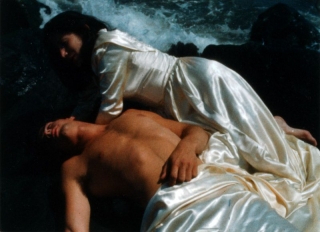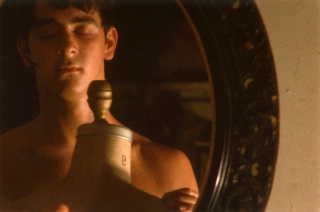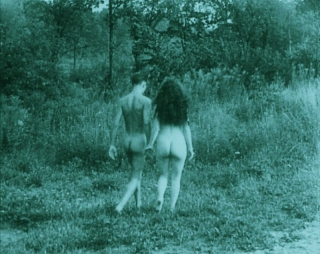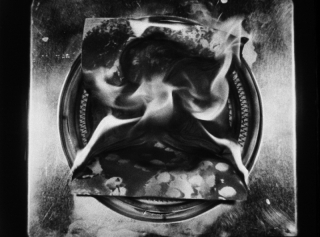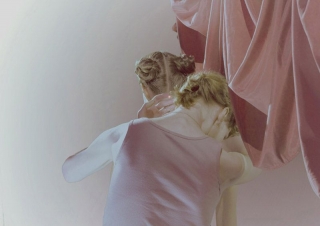Date: 15 November 2008 | Season: Robert Beavers 2008
ROBERT BEAVERS STUDY DAY: Voice, Interval & Place
Saturday 15 November 2008, from 1-6pm
Norwich Aurora Festival
Robert Beavers will present an afternoon seminar on personal filmmaking following the themes of voice, interval and place. This rare opportunity to participate in an extended dialogue with the filmmaker will include screenings and detailed discussion of works by Robert Beavers, Gregory J. Markopoulos, Bruce Baillie and several contemporary filmmakers working in 8mm and 16mm.
“Starting from an observation made by the poet, Elizabeth Bishop, that theories can only be about others’ works or one’s own in retrospect or wishful thinking, I hope to open a discussion about what a filmmaker’s voice might be and how it is sometimes related to a sense of place. I will present films by others and an early work of my own, and time allowing, I may discuss one or two points towards the future to fulfil our poet’s category of wishful thinking.
“While viewing these films, I hope to speak about some of the material differences and discuss with the participants how these differences have affected the resulting films. This can provide participants with some background to this area of filmmaking and an opportunity for a comparison of sources for their own decisions as filmmakers or dedicated film spectators.
“I will concentrate also upon qualities of the senses in filmmaking and the search for a richness in the development of technique to give form to thought and emotion.” —Robert Beavers
Films to be shown and discussed:
Francois Boué, Tectonica: Ur-Haus (Yawpo), 1998-99, Super-8, 18fps, colour, sound, 7 min
Francois Boué, Micropolis: Tabu Mana, 1998, Super-8, 18fps, colour, silent, 3 min
Francois Boué, Tabu Mana II: Gods to Go, 1998, Super-8, 18fps, b/w, silent, 4 min
Francois Boué, Goetheanum, 2005, Super-8, 18fps, colour & b/w, silent, 8 min
Bruce Baillie, Valentin de las Sierras, 1967, 16mm, 24fps, colour, sound, 10 min
Ute Aurand, Maria und die Welt, 1995, 16mm, 24fps, colour & b/w, sound, 15 min
Robert Beavers, The Stoas, 1991-97, 16mm, 24fps, colour, sound, 22 min
15 minute break
Helga Fanderl, Tombs, 2004, 16mm, 18fps, b/w, silent, 3 min
Helga Fanderl, Broadway, 2006, 16mm, 18fps, b/w, silent, 3 min
Helga Fanderl, Drawing Cobblestones, 2006, 16mm, 18fps, colour, silent, 3 min
Helga Fanderl, Golf House, 2006, 16mm, 18fps, colour, silent, 3 min
Helga Fanderl, Leaden Waves, 2006, 16mm, 18fps, colour, silent, 3 min
Helga Fanderl, Shadows on a Red Wall, 2006, 16mm, 18fps, colour, silent, 3 min
Helga Fanderl, Skating, 2005, 16mm, 18fps, colour, silent, 3 min
Helga Fanderl, Warriors Mark, 2007, 16mm, 18fps, colour, silent, 2 min
Helga Fanderl, Louïe, 2007, 16mm, 18fps, colour, silent, 3 min
Helga Fanderl, Glaciers, 2006, 16mm, 18fps, colour, silent, 1 min
Gregory J. Markopoulos, Bliss, 1967, 16mm, 24fps, colour, optical sound, 6 min
Gregory J. Markopoulos, Eniaios IV, Reel 2, late 1980s, 16mm, 24fps, colour, silent, c.25 min
Jeannette Muñoz, Cronica : El Cortijo, 2000-06, 16mm, 24fps, colour & b/w, silent, 15 min
Jeannette Muñoz, Envios (excerpts), 2003-08, 16mm, 24fps, colour & b/w, silent, c.10 min
Ute Aurand, Am Meer, 1995, 16mm, 24fps, colour, sound, 3 min
PROGRAMME NOTES
ROBERT BEAVERS STUDY DAY: Voice, Interval & Place
Saturday 15 November 2008, from 1-6pm
Norwich Aurora Festival
Filmmakers to be presented: Ute Aurand, Bruce Baillie, Robert Beavers, Francois Boué, Helga Fanderl, Gregory J. Markopoulos, Jeannette Muñoz.
Films to be shown and discussed include:
THE STOAS
Robert Beavers, 1991-97, 16mm, colour, sound, 22 min
“I sought in these small industrial arcades the spaces which can be seen first from one side and then from the other, a shape of emptiness, then the divinity of the river – this deep sense of appearance – and finally the grasping of the grape.” (Robert Beavers)
BLISS
Gregory J. Markopoulos, 1967, 16mm, colour, sound, 6 min
and
ENIAIOS IV, Reel 2 (Nefeli Photos)
Gregory J. Markopulos, 1967/91, 16mm, colour, sound, 30 min
Bliss is a kaleidoscopic study of the interior of a small, Byzantine church on the Island of Hydra. This will be rare opportunity to view and compare the original version, edited spontaneously in camera over the two days it was shot, and the revised and extended treatment of the same footage, in which the images are isolated by measures of black frames.
MARIA UN DIE WELT
Ute Aurand, 1995, 16mm, black and white, sound, 15 min
The filmmaker Maria Lang moved to the countryside to take care of her elderly mother. Maria und die Welt (Maria and the World), by her friend Ute Aurand, is a portrait of that relationship and its setting.
VALENTIN DE LAS SIERRAS
Bruce Baillie, 1967, 16mm, colour, sound, 10 min
“Skin, eyes, knees, horses, hair, sun, earth. Old song of Mexican revolutionary hero, Valentin, Sung by blind Jose Santollo Nasido en Santa Crus de la Soledad.” (Bruce Baillie)
Back to top
Date: 16 November 2008 | Season: Robert Beavers 2008
ROBERT BEAVERS: PROGRAMME 2
Ssunday 16 November 2008, at 3:30pm
Norwich Aurora Festival
RUSKIN
Robert Beavers, 1975/1997, 35mm, black-and-white and colour, sound, 45 min
Filmed in Italy (Venice), Switzerland (the Grisons) and England (London)
I had been visiting my family in Massachusetts and found the three volumes of ‘The Stones of Venice’, which a childhood friend had given me. It must have been one of the first American editions with those wonderful illustrations by Ruskin. I read it and hoped that I could do something with it in film. In 1973, I went to Venice with Gregory Markopoulos. At the time, Italy was not expensive; we lived for three or four months in a hotel while I filmed. The two other filming locations are Soglio in the Grisons, and Portland Place in London. I filmed the Venetian locations, sometimes at three different hours of the day, in colour and filmed specific architectural details at the same locations in black and white. It was edited with a soundtrack of fragments read from Ruskin’s text. Later, in 1975, I decided to add a coda, which took almost a year to do and involved changing the sound of the original. The coda is composed of the pages of ‘Unto This Last’ and the play of shadows between the pages intercut with falling snow. I removed the spoken fragments of text from the main part of the film and recorded sounds from the various locations. I also removed Ruskin’s date of death that had been placed at the end of the film before the coda. (Robert Beavers)
PITCHER OF COLORED LIGHT
Robert Beavers, 2007, 16mm, colour, sound, 24 min
Cast: Dorothy Mahoney
Filmed in USA (Falmouth)
I have filmed my mother’s house and her garden. The shadows play an essential part in the mixture of loneliness and peace that exists here. The seasons move from the garden into the house, projecting rich diagonals in the early morning or late afternoon. Each shadow is a subtle balance of stillness and movement; it shows the vital instability of space. Its special quality opens a passage to the subjective; a voice within the film speaks to memory. The walls are screens through which I pass to the inhabited privacy. We experience a place through the perspective of where we came from and hear someone else’s voice through our own acoustic. The sense of place is never separate from the moment. (Robert Beavers)
Date: 28 March 2009 | Season: Gregory Markopoulos 2009 | Tags: Gregory Markopoulos, London Lesbian & Gay Film Festival
GREGORY J. MARKOPOULOS
London Lesbian & Gay Film Festival 2009
28—30 March 2009
London BFI Southbank NFT3
The London Lesbian & Gay Film Festival presents two programmes of rarely screened films by Gregory J. Markopoulos.
PROGRAMME 1
Gregory J. Markopoulos, Twice A Man, 1963, 49 min
Gregory J. Markopoulos, Ming Green, 1966, 7 min
PROGRAMME 2
Gregory J. Markopoulos, Eros, O Basileus, 1967, 45 min
Gregory J. Markopoulos, Through a Lens Brightly: Mark Turbyfill, 1967, 15 min
Curated by Mark Webber, with thanks to Temenos Verein.
Date: 28 March 2009 | Season: Gregory Markopoulos 2009 | Tags: Gregory Markopoulos, London Lesbian & Gay Film Festival
GREGORY J. MARKOPOULOS
London Lesbian & Gay Film Festival 2009
Saturday 28 March 2009, at 4:30pm
London BFI Southbank NFT3
TWICE A MAN
Gregory J. Markopoulos, USA, 1963, 16mm, colour, sound, 49 min
with Paul Kilb, Olympia Dukakis, Albert Torgesen
Twice A Man is a fragmented re-imagining of the Greek myth of Hippolytus, who was killed after rejecting the advances of his stepmother. Markopoulos’ vision transposes the legend to 1960s New York and has its main character abandon his mother for an elder man. Employing sensuous use of colour, the film radicalised narrative construction with its mosaic of ‘thought images’ that shift tenses and compress time. One of the touchstones of independent filmmaking, Twice A Man was made in the same remarkable milieu as Scorpio Rising and Flaming Creatures by a filmmaker named ‘the American avant-garde cinema’s supreme erotic poet’ by its key critic P. Adams Sitney.
MING GREEN
Gregory J. Markopoulos, USA, 1966, 16mm, colour, sound, 7 min
An extraordinary self-portrait conveyed through the multiple layered superimpositions of the filmmaker’s sparsely furnished room.
Date: 30 March 2009 | Season: Gregory Markopoulos 2009 | Tags: Gregory Markopoulos, London Lesbian & Gay Film Festival
GREGORY J. MARKOPOULOS
London Lesbian & Gay Film Festival 2009
Monday 28 March 2009, at 8:45pm
London BFI Southbank NFT3
EROS, O BASILEUS
Gregory J. Markopoulos, USA, 1967, 16mm, colour, sound, 45 min
with Robert Beavers
Markopoulos’ invocation of Eros merges classical and contemporary imagery by placing the male god of love in an artists’ loft. The sole protagonist, predominantly naked, appears in a series of tableaux surrounded by icons of creativity, including paintings, books and filmmaking equipment. This sculptural study of the human form is energised by flash frames, stylised fades, and Strauss’ tone-poem ‘Ein Heldenleben’. Eros is portrayed by the young filmmaker Robert Beavers, who had recently moved to New York after seeing films by Markopoulos and other New American Cinema pioneers. Both soon left America for Europe, where they remained together until Markopoulos’ death in 1992.
THROUGH A LENS BRIGHTLY: MARK TURBYFILL
Gregory J. Markopoulos, USA, 1967, 16mm, colour, sound, 15 min
The life of painter, dancer and poet Mark Turbyfill, seen in his 70th year, is evoked through traditional portraiture and personal objects.
Date: 24 October 2009 | Season: London Film Festival 2009 | Tags: London Film Festival
THE TIMES BFI 53rd LONDON FILM FESTIVAL
24—25 October 2009
London BFI Southbank
The London Film Festival’s annual weekend dedicated to artists’ film and video will take place on 24-25 October 2009.
The programme presents a varied selection of international works ranging from the contemporary ethnography of Mirza/Butler to Jim Trainor’s witty, naïve animation of ancient civilisations. Gustav Deutsch introduces FILM IST. a girl & a gun, a battle of the sexes told through footage from early cinema, and a special event featuring new prints of films by Hollis Frampton complements the recent publication of his collected writings.
Established filmmakers Lewis Klahr, Mara Mattuschka and Matthias Müller are shown alongside younger artists Paul Abbott, Jana Debus, and Laida Lertxundi, who are screening in the festival for the first time. Continuous installations by Laure Prouvost and Victor Alimpiev will be presented in the BFI Southbank Studio.
Elsewhere in the festival, look for new features by Johan Grimonperez, Andrew Kötting, Ken McMullen and Sam Taylor-Wood, preservations of The Savage Eye and Far From Vietnam and the rediscovery of Henri-Georges Clouzot’s Inferno.
Date: 24 October 2009 | Season: London Film Festival 2009 | Tags: London Film Festival
MONOLOG
Saturday 24 October 2009, 12-7pm
London BFI Southbank Studio
A new work made for the Festival turns its attention to the viewer and the room itself. ‘Come inside, I’m going to explain a few things. Just about you and the space we’re in. It’s quite warm in here, you should take off your jacket …’
MONOLOG
Laure Prouvost, UK-France, 2009, video, colour, sound, 9 min (continuous loop)
Prouvost weaves whimsical and intimate narratives that both mesmerise and disturb, blurring the boundary between reality and fantasy in ways that parody traditional narrative structures. Things never seem to quite match up in Prouvost’s stories, leaving the viewer with the task of trying to fix these somewhat messy and imperfect narratives that begin full of mystery and enchantment only to unravel and shatter any promise of a happy ending. (Jamie Wyld)
Laure Prouvost was born in Lille in 1978 and lives and works in London. She received the EAST International award for 2009 and has also recently exhibited at After the Butcher Berlin, Monika Bobinska Gallery and MOT London, and the Zoo Art Fair. Her videos are distributed by LUX. Prouvost has been director of tank.tv, the online moving images gallery, since 2003. www.laureprouvost.com
Date: 24 October 2009 | Season: London Film Festival 2009 | Tags: London Film Festival
HOLLIS FRAMPTON: HAPAX LEGOMENA
Saturday 24 October 2009, at 2pm
London BFI Southbank NFT3
Hollis Frampton, a key figure of the American avant-garde, was an artist and theoretician whose practice closely resonates with contemporary discourse. The series of seven films known as Hapax Legomena is, alongside Zorns Lemma, one of his most distinguished achievements, and will be presented in its entirety on new preservation prints. Predating Magellan, the ambitious ‘metahistory’ of film left unfinished by his early death in 1984, Hapax Legomena traces Frampton’s own creative progression from photographer to filmmaker. It dissects sound/image relationships, incorporates early explorations of video and television, and looks forward to digital media and electronic processes. Though notoriously rigorous, Frampton’s films are infused with poetic tendencies and erudite wit, sustaining a dialogue with the materials of their making, and the viewer’s active participation in their reception.
‘Hapax legomena are, literally, ‘things said once’ … The title brackets a cycle of seven films, which make up a single work composed of detachable parts … The work is an oblique autobiography, seen in stereoscopic focus with the phylogeny of film art as I have had to recapitulate it during my own fitful development as a filmmaker.’ (Hollis Frampton)
Hollis Frampton, (nostalgia), USA, 1971, 36 min
As a sequence of photographs is presented and slowly burned, a narrator recounts displaced anecdotes related to their production, shifting the relationship between words and images.
Hollis Frampton, Poetic Justice, USA, 1972, 31 min
A ‘film for the mind’ in which the script is displayed page by page for the viewer to read and imagine.
Hollis Frampton, Critical Mass, USA 1971, 16 min
Frampton’s radical editing technique disrupts and amplifies the already impassioned argument of a quarrelling couple.
Hollis Frampton, Travelling Matte, USA, 1971, 34 min
‘The pivot upon which the whole of Hapax Legomena turns’ uses early video technology to interrogate the image.
Hollis Frampton, Ordinary Matter, USA, 1972, 36 min
This ‘headlong dive’ from the Brooklyn Bridge to Stonehenge is a burst of exhilarated consciousness.
Hollis Frampton, Remote Control, USA, 1972, 29 min
‘A ‘baroque’ summary of film’s historic internal conflicts, chiefly those between narrative and metric/plastic montage; and between illusionist and graphic space.’
Hollis Frampton, Special Effects, USA, 1972, 11 min
Stripping away content leaves only the frame. ‘People this given space, if you will, with images of your own devising.’
Hapax Legomena has been preserved through a major cooperative effort funded by the National Film Preservation Foundation and undertaken by Anthology Film Archives, MoMA, the New York University Moving Image Archiving and Preservation Program, and project conservator Bill Brand.
‘On the Camera Arts and Consecutive Matters: The Writings of Hollis Frampton’, edited by Bruce Jenkins, was published by MIT Press in April 2009. The collection presents Frampton’s critical essays (many written for Artforum and October) along with additional material – including lectures, correspondence, interviews, production notes and scripts – which display his distinctive perspectives on photography, film, video, and the plastic and literary arts.
Also Screening: Thursday 29 October 2009, at 6:30pm, NFT3
PROGRAMME NOTES
HOLLIS FRAMPTION: HAPAX LEGOMENA
Saturday 24 October 2009, at 2pm
London BFI Southbank NFT3
Hapax legomena are, literally, ‘things said once’. The Greek scholarly jargon refers to those words
that occur only a single time in the entire oeuvre of an author, or in a whole literature. The title brackets a cycle of seven films, which make up a single work composed of detachable parts, each of which may be seen separately for its own qualities. The work is an oblique autobiography, seen in stereoscopic focus with the phylogeny of film art as I have had to recapitulate it during my own fitful development as a filmmaker. Hapax Legomena incorporates what I could learn along the way of making it, and includes my own false starts and blind alleys … what T.E. Hulme once called ‘the cold walks, and the lines that lead nowhere’. Such ‘double-vision’ – that is, the superimposition of a personal myth of the history of one’s art upon a factual account of one’s own persona – certainly does not originate with me. At least, I believe I see ample precedent in the last two books of James Joyce. (Hollis Frampton)
(NOSTALGIA)
Hollis Frampton, USA, 1971, 16mm, b/w, sound, 36 min
The narrative art of most young men is autobiographical. Since I have had little narrative experience, it seemed reasonable to accept biography as a convention, rather, however little information was available to me. My subject, hoping abjectly to be taken for a man of his time, had practiced rigorous self-effacement for a decade or more. So I was forced into examining his leavings and middens, like an archaeologist sifting for ostracizing pot shards. Since he had once been myself, I knew exactly where to look. Random debts and documents aside, he had left behind some thousands of still photographs made during his apprenticeship to the art I expound. Because my results were to be made public, I chose a mere dozen of these specimens to examine, leaving the rest for later investigators who would be doubly fortunate: first in their sentiment for their antagonist, and again in their intimacy with his work. (HF)
POETIC JUSTICE
Hollis Frampton, USA, 1972, 16mm, b/w, silent, 31 min
In Poetic Justice, Frampton presents us with a ‘scenario’ of extreme complexity in which the themes of sexuality, infidelity, voyeurism are ‘projected’ in narrative sequence entirely through the voice telling the tale – again it is the first person singular speaking, however, in the present tense and addressing the characters as ‘you’, ‘your lover’, and referring to an ‘I’. We see, on screen, only the physical aspect of a script, papers resting on a table … and the projection is that of a film as consonant with the projection of the mind. (Annette Michelson)
CRITICAL MASS
Hollis Frampton, USA, 1971, 16mm, b/w, sound, 16 min
As a work of art I think Critical Mass is quite universal and deals with all quarrels (those between men and women, or men and men, or women and women, or children, or war.) It is war! … It is one of the most delicate and clear statements of inter-human relationships and the difficulties of them that I have ever seen. It is very funny, and rather obviously so. It is a magic film in that you can enjoy it, with greater and greater appreciation, each time you look at it. Most aesthetic experiences are not enjoyable on the surface. You have to look at them a number of times before you are able to fully enjoy them, but this one stands up at once, and again and again, and is amazingly clear. (Stan Brakhage)
TRAVELLING MATTE
Hollis Frampton, USA, 1971, 16mm, b/w, silent, 34 min
One aspect of the film seems quite clear. Frampton is creating a metaphor for the artist, whose hand frames or moulds the world available to his perceptions according to the components of his vision and the limitations of his medium. Other aspects of this metaphor are suggested by Frampton’s inclusion of this revealing comment by Stan Brakhage in the Filmmakers’ Co-operative Catalogue: ‘This film metaphors an entire human life: birth, sex, death – the framing device is the fingers and palm of the maker’s hand, wherein others only attempt to read the future.’ While the events one sees through the opening in Frampton’s hand are generally fleeting and unspecific, it is possible that Brakhage’s description relates to the events we see through the hand: that the artist’s life begins when his medium begins to function, that he wanders through the world like a character out of Samuel Beckett, seeing various things, moving uphill for long periods until he attains, at least momentarily, a fuller vision (in one instance the hand comes away from the lens for a second), then moving back downhill until ‘his batteries run down’ and all sensation ceases. (Scott MacDonald)
ORDINARY MATTER
Hollis Frampton, USA, 1972, 16mm, b/w, sound-on-cd, 36 min
I suppose I think of it as a kind of acceleration from Travelling Matte, the eye is groping and feeling its way and staggering, and so forth. And in Ordinary Matter the need somehow to worry about those words and still photographs, and so forth, is behind. Ordinary Matter is for me a kind of ecstatic, headlong dive. (And it goes through nature, architecture, high peaks of contemporary civilization, and through the oldest monuments that we have – the scope of it in time and space is so wide …) and finally the eye that was trying to see out, through the little hole – through the fist, in Travelling Matte opens up and does, to an extent, really see out, or I feel it does, and ends with something that is a very old image in my eye, of running through corn fields as a child, with the leaves slapping me in the face, and the sun hitting me, and so forth … (HF interviewed by Jonas Mekas)
REMOTE CONTROL
Hollis Frampton, USA, 1972, 16mm, b/w & colour, sound, 29 min
A ‘baroque’ summary of film’s historic internal conflicts, chiefly those between narrative and metric/plastic montage; and between illusionist and graphic space. It incorporates three apposite ‘found’ narratives, condenses five ways of making, and includes a ‘surprise’ out of Haydn (or S.M. Eisenstein’s Ivan, Part II). (HF)
SPECIAL EFFECTS
Hollis Frampton, USA, 1972, 16mm, b/w, sound, 11 min
The frame itself, which divides what is present to consciousness from what is absolutely elsewhere, is tempered here by the breath, tremor, heartbeat of the perceiver. People this given space, if you will, with images of your own devising. The soundtrack was generated on a Buchla synthesizer at the University of Pittsburgh, through the kind intercession of Victor Grauer. (HF)
Download Programme Notes PDF
Back to top
Date: 24 October 2009 | Season: London Film Festival 2009 | Tags: London Film Festival
HUMAN NATURE
Saturday 24 October 2009, at 7pm
London BFI Southbank NFT3
Friedl vom Gröller, Passage Briare, Austria, 2009, 3 min
A meeting of friends in a Paris backstreet, and an unexpected revelation.
Josef Dabernig, Hotel Roccalba, Austria, 2009, 10 min
In a subtle choreography, the occupants of a small Alpine hotel pass a lazy afternoon. Not much happens, but all may not be as it appears.
Jana Debus, Gregor Alexis, Germany, 2008, 20 min
The filmmaker’s schizophrenic brother recounts personal experiences, slipping between first and third person. The locations chosen for this portrait – a desolate apartment and a wasteland littered with abandoned machinery – are indicative of the condition of someone potentially as vulnerable as the insects that collect on his windowsill.
Ken Jacobs, The Discovery, USA, 2008, 4 min
Tom’s dextrous parlour game attracts unwanted attention. A stolen moment, frozen in time, now re-animated for all to see.
Jim Trainor, The Presentation Theme, USA, 2008, 14 min
As primitive Magic Marker drawings illustrate the myths and rituals of the ancient Moche civilisation, a disparaging narrator describes the tormented trials of a hapless creature amongst goblets of blood, fanged men and a sacrificial priestess.
Mara Mattuska & Chris Haring, Burning Palace, Austria, 2009, 32 min
This new collaboration between Mattuschka and Vienna’s Liquid Loft takes us behind the velvet curtains of the Burning Palace, whose peculiar inhabitants have an itch they just can’t scratch.
PROGRAMME NOTES
HUMAN NATURE
Saturday 24 October 2009, at 7pm
London BFI Southbank NFT3
PASSAGE BRIARE
Friedl vom Gröller, Austria, 2009, 16mm, b/w, silent, 3 min
A woman, a man, a smile. They sit in the sun, and what links them is the film’s real surprise: a matter-of-fact gesture which is probably taboo for others. It’s up to the film itself to reveal what this gesture is. The anarchic humour of Passage Briare liberates the viewer for a brief, beautiful moment from the fear of getting old. (Maya McKechneay)
HOTEL ROCCALBA
Josef Dabernig, Austria, 2009, 35mm, b/w, sound, 10 min
Apparently over two years in the making (the artist displayed the script in a gallery exhibition in 2007, with suitably structural/conceptual directorial commentary), Hotel Roccalba is a small wonder, the sort of film that somehow manages to astonish with its precision while at the same time allowing enough basic human breathing room to permit limitless discovery. Like the best formalist efforts – Gerhard Richter paintings, Anton Webern compositions – you can naturally learn Dabernig’s film by heart because it does observe a kind of schematic organization. But it continues to unfold, with a warm, enveloping humour all the same. What really defines Hotel Roccalba is a bizarre, thrilling sense of the disorganized, random stuff of life being invisibly, imperceptibly choreographed; a God-like aspect that is gradually revealed, becoming a kind of Cubist hysteria. (Michael Sickinski)
GREGOR ALEXIS
Jana Debus, Germany, 2008, video, colour, sound, 20 min
An empty house. Beautiful, unobtrusive, rapt images of a demolished landscape. A cautious but moving documentary portrait of the director’s schizophrenic brother. (Kunstfilm Biennale, Cologne)
THE DISCOVERY
Ken Jacobs, USA, 2008, video, colour, silent, 4 min
She thought Tom was alone. Have we people been just as we are for centuries and centuries? With no essential changes beyond our slang?(Ken Jacobs)
THE PRESENTATION THEME
Jim Trainor, USA, 2008, 16mm, b/w, sound, 14 min
The Presentation Theme is based on something very specific. This is not explicit in the film itself, which is elusive on that score – although I would like the audience to have the feeling that there is something ‘real’ at the core of it. Or, to put it another way, that they would suspect, through the specificity of the references, that the filmmaker didn’t just make everything up himself. I got the idea from certain archaeology books, which describe an ancient Peruvian culture called the Moche. They existed long before the Inca, around 100 to 800 AD, then disappeared. They left a lot of pottery behind, and some of the pottery is moulded into shapes of supernatural figures, rulers, animals, narrative scenes; and other pottery is plain in shape but is covered in painting – specifically cartoonish-looking figures, again enacting mythological themes. All of the art is quite mysterious, as there is no-one to interpret it for us (and no written language, of course). The moulded pottery often has erotic themes and the painted pottery often has themes of warfare and human sacrifice. ‘The Presentation Theme’ in Moche archaeology refers to the human sacrifice narrative, in which the priests and priestesses are ultimately presented with goblets of victims’ blood. (Jim Trainor)
BURNING PALACE
Mara Mattuska & Chris Haring, Austria, 2009, video, colour, sound, 32 min
Austrian filmmaker Mara Mattuschka has already worked with choreographer Chris Haring several times before and has transferred the dance performances created by him and his company ‘liquid loft’ into experimental films. After Legal Errorist (2005), Part Time Heroes (2007) and Running Sushi (2008) Mattuschka committed herself to Chris Haring’s choreographic trilogy ‘Posing Project’ and made a film called Burning Palace out of the second, award-winning part ‘The Art of Seduction’. Five dancers journey through the emotions of Eros, in reality and in the imagination, in mythology and in the present day. Accompanied by strange-seeming sound collages, they stray through the labyrinthine corridors of the ‘Burning Palace’ hotel. An ecstatic, melancholy epic of the tension that ensures survival and makes the Earth move. (www.impulstanz.com)
Back to top
Date: 25 October 2009 | Season: London Film Festival 2009 | Tags: London Film Festival
MY ABSOLUTION
Sunday 25 October 2009, from 12-7pm
London BFI Southbank Studio
Alimpiev’s work imbues the simplest gestures with mystery and consequence. An actress performs a sequence of enigmatic actions towards the nape of a second woman’s neck in a performance that creates an almost sculptural tension which is never quite released.
MY ABSOLUTION
Victor Alimpiev, Russia-Netherlands, 2008, video, colour, sound, 8 min
Victor Alimpiev’s videos are experiments in controlled spontaneous behaviour. Whether providing a close-up view of a singing exercise in which one woman instructs another on proper breathing techniques (My Breath, 2007) or juxtaposing a group of schoolgirls rapping on their desks with the ragings of a summer storm (Summer Lightnings, 2004), Alimpiev reveals our concomitant proximity to and distance from the natural world. The desperation implicit in his attempt to align the rational and the irrational is echoed in the camera’s tight frame and abrupt interruptions. The resulting tension derives from both the exhilarating effort to master nature’s rhythms and the manifest impossibility of achieving this task. (Claire Gilman)
Victor Alimpiev was born in Moscow in 1973 and is represented by Regina Gallery Moscow and Galerie Anita Beckers Frankfurt. He has recently exhibited at the Moscow and Berlin biennales, SMAK Ghent, Modern Art Oxford and Impakt Festival Utrecht. His solo show “To Trample Down an Arable Land” is currently on display at the Ikon Gallery Birmingham until 15 November 2009.
